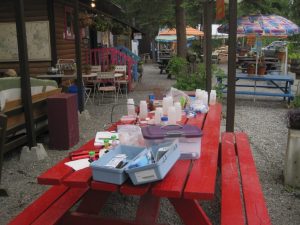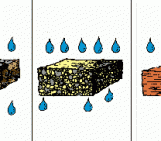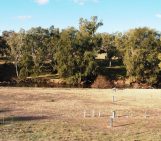
Post by Matt Herod
Welcome to the first edition of groundwater speed dating. In today’s post I introduce you to a motley crew of isotopes and chemicals that hydrogeologists and geochemists use to date the age of groundwater. After meeting all of the contestants it will be up to you to pick your favourite and perhaps propose a second date. On your groundwater samples that is.

Starting to find some answers on water chemistry of baseflow samples from the Yukon. The first step in groundwater dating…picnic style. (Photo: Matt Herod)
Before I introduce you to our contestants I should briefly make it clear why groundwater dating is important. Understanding how old groundwater is may be one of the most, if not the most important aspect of protecting groundwater as a resource and preventing depletion of groundwater reserves from overpumping. For example, pumping an aquifer with a groundwater age of 10 years can be done semi-sustainably as any water extracted will take ~10 years to replace. However, pumping water with an age of 100,000 years is exploiting a nearly non-renewable resource. There may be lots of it, but the aquifer could take a long time to recover. Think of it like this: the water being pumped has to come from somewhere. Pumping could draw more water into the aquifer from recharge (not always an option) to replace what is lost, the water pumped could be from groundwater already stored in the aquifer, or it could be groundwater that was leaving the aquifer via discharge into a river or lake that is now diverted to your well.
Another great reason to know the groundwater age is to assess the vulnerability of an aquifer to contamination. If groundwater is young it is likely that the host aquifer is more vulnerable to contamination. Furthermore, knowing the age of groundwater throughout an aquifer will also allow a hydrogeologist to assess how quickly contamination will spread and if it can be contained. There are other reasons that it is beneficial to know the age of groundwater and if you’re interested I refer you to some of the references below.
I should also mention that the clock on a groundwater age starts once it becomes groundwater. That means that once my rain drop infiltrates into the ground and reaches the water table. The time it takes for the water to infiltrate through the soil layer is not included in the date which can add several months. Therefore, when I say groundwater is one year old, this means that it was likely rain from last year that has now reached the well, but it may be slightly older when you factor in the vadose zone travel time.
Are you ready to meet your speed dating contestants!? Pick the one that you’d like to date (the best isotope for your particular groundwater sample).
Note: You’ll see reference to cosmic rays a lot below. For reference see this primer in a previous blog post.
Name: Carbon-14
Nickname: 14C, The Cool One
Personality: Bada^s, Awesome
Half-life: 5730 years
Groundwater age range: 100 -100,000 years
A little about me:
14C, nicknamed radiocarbon, is the isotope that everyone wants to meet. Used by hydrogeologists in a vast range of dating applications for almost any organic material (organic = has carbon in it) it can also be used to date groundwater. 14C is produced by cosmic ray interactions with nitrogen in the atmosphere. 14C was also produced in significant quantities by atomic weapons testing and created a “bomb pulse” like our contestant tritium below which is also used to date groundwater. The great thing about radiocarbon is that since we know exactly how much is produced we can always estimate an age. However, dater beware. The age obtained from 14C and many other groundwater dating tools is the apparent age, which means it is inexact and vulnerable to aggregation errors when mixing young and old water mix, and requires the dater to consider other sources of inorganic carbon that contain no 14C such as ancient limestone. There are ways to correct for these issues, but great care must be taken so don’t be deterred from choosing 14C…maybe a bit of that coolness will rub off on you!? (Of course, as hydrogeologists we don’t need any extra coolness).
Name: Krypton 85 and Krypton 81
Nickname: 85Kr and 81Kr, The Twins
Personality: Different, One short tempered, the other slow to anger
Half-life: 81Kr: 10.75 years, 85Kr: 230,000
Groundwater age range: 10 – 100 and 10,000 -1,000,000 years (using different Kr isotopes)
A little about me:
These two twins could not be more different. Both are isotopes of krypton but with hugely different applications. You won’t see them in Twins magazine (twinsmagazine.com). The source of 85Kr is low level emissions from the nuclear industry, mainly fuel reprocessing. It has a short half-life meaning it can only be detected in groundwater a few decades old.
On the opposite end of the spectrum 81Kr is used for dating extremely ancient groundwater and is a relatively new dating tool for hydrologists. See me previous post on atom trap trace analysis for the details on this method that has made 81Kr dating possible. 81Kr is produced by cosmic ray interactions with gases in the atmosphere that become incorporated into rain that can recharge groundwater. 81Kr is the newest tool in the isotope hydrologists kit and has been used to date waters over 100,000 years old! It isn’t often you see twins so different than this pair. Nevertheless, they may be worth a longer look in your future?
Name: Tritium
Nickname: 3H, The Friendly One
Personality: Popular, Nice
Half-life: 12.3 years
Groundwater age range: 10-100 years
A little about me:
Tritium is the popular isotope in groundwater dating. Of all the isotopes in this competition, 3H is picked more often than the rest combined. Tritium has a short half life making it an ideal tracer and dating tool of young groundwater. Before the 1950’s all tritium in groundwater was natural and produced by cosmic ray interactions in the atmosphere. However, following the atomic weapons testing in the 1950’s and 60’s the tritium concentration in the atmosphere, rain and groundwater increased drastically. This made it possible to date groundwater using what hydrogeologists know as the “bomb peak”. This method has been enhanced using the decay product of tritium, 3He, as well to overcome the loss of tritium by decay over the time since weapon’s testing ended. While 3H may become less useful in the northern hemisphere as the bomb peak decays, the natural variability of 3H production in the southern hemisphere with fewer anthropogenic sources suggests 3H may become ever more useful! http://www.hydrol-earth-syst-sci-discuss.net/hess-2016-532/. Don’t be deterred by it’s popularity and the crowds, tritium is the real deal!
Name: Chlorine-36
Nickname: 36Cl, The Hard to Get
Personality: Evasive, Sends Mixed Signals
Half-life: 301,000 years
Groundwater age range: 10,000 – 1,000,000
A little about me:
36Cl is produced in the atmosphere by cosmic rays and has been used widely for dating ancient groundwater that is tens to hundreds of thousand years old. However, chlorine-36, while popular, is also “high-maintenance”: 36Cl requires more than just a run of the mill accelerator mass spectrometer (AMS) to measure. Indeed, in order to measure 36Cl on an AMS it needs to have the ability to remove the isobar sulphur-36 that interferes with the measurement of the much rarer (and thus sought-after by hydrogeologists) atoms of 36Cl in a sample. Only the highest energy AMS instruments or those with special capabilities, such as an isobar separator, can perform the measurement of 36Cl accurately. Nevertheless, sometimes it is worth putting in the extra effort for the reward. Will you?
Name: Uranium 234-238 Disequilibrium
Nickname: U-Disequilibrium (234U/238U), The Complicated One
Personality: Confusing, Game Player
Half-life: N/A
Groundwater age range:
A little about me:
You don’t come across U-disequilibrium dating that often, but when you do have a beer. U-disequilibrium is a bit mind-bending and requires a very thorough understanding the of the nuclear and geochemical processes at work in your sample location. Basically, it works because as 238U decays in rocks it shoots out alpha radiation, aka. 4He nuclei, at high energies. These bullets of helium break the crystal lattice of the minerals around the 238U atom allowing groundwater the get in. The groundwater then preferentially dissolves some of the 238U grand-daughter, 234U. This means there is more 234U than 238U dissolved in the water (by activity). The (activity) ratio of 234U/238U is greater than one and is predictable over time if you know the geochemical and hydrogeological characteristics of the system. This means you can correlate the ratio you measure to an age. This is an oversimplification of the method, but at it’s core that’s how it works. If you’re persistent, and work hard to understand U-disequilibrium the date is worth it. Will you put in the hard work?
Name: Iodine-129
Nickname: 129I, The Forgotten One
Personality: Quiet, Interesting
Half-life: 15,700,000 years
Groundwater age range: < 80,000,000 years
A little about me:
My personal fave but so forgotten it didn’t merit the figure above! See my PhD thesis for why. The short of it is that I think 129I has a wide variety of applications but we don’t yet fully understand its transport in groundwater and thus applying it is difficult. Therefore, people often overlook 129I for groundwater dating. It is similar to 36Cl in that it requires an AMS to measure, and they are both halogens. 129I has a very long half life and it is interesting because it is produced in three ways: cosmic rays, 238U fission in rocks, and nuclear fuel reprocessing. This makes it a tracer of modern groundwater and allows it to constrain the age of water that is less than 80 million years old as well! If you’re willing to take a chance and explore, perhaps 129I could be the one for you!?
Pick the isotope you’d like to date and leave a comment below!
Feature image from warsaw social.





Pingback: GeoSphere | Groundwater Speed Dating at Water Underground